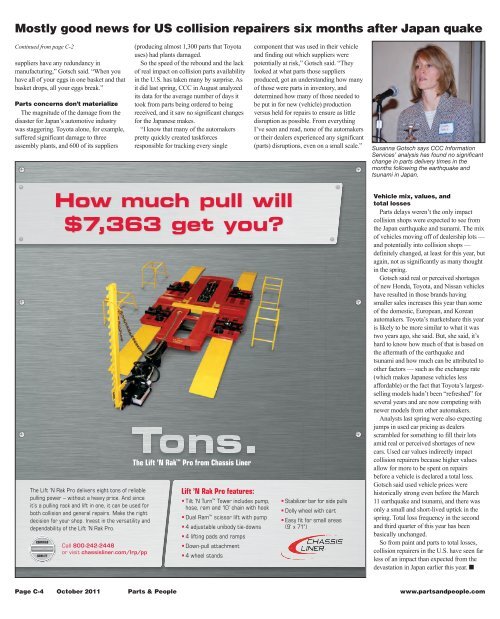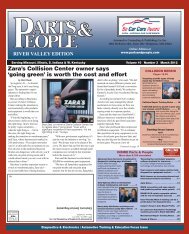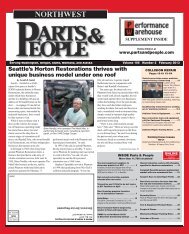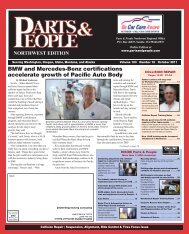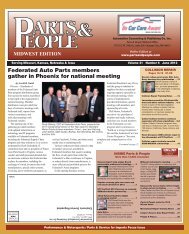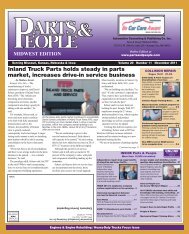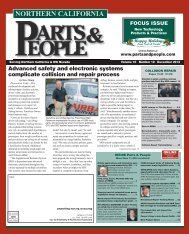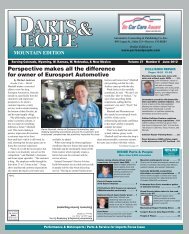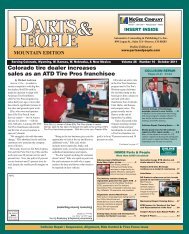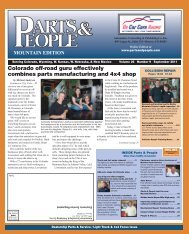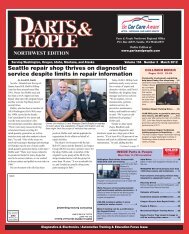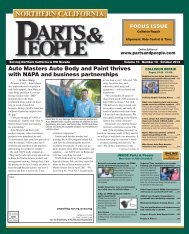SC October2011.pdf - Parts & People
SC October2011.pdf - Parts & People
SC October2011.pdf - Parts & People
You also want an ePaper? Increase the reach of your titles
YUMPU automatically turns print PDFs into web optimized ePapers that Google loves.
Mostly good news for US collision repairers six months after Japan quake<br />
Continued from page C-2<br />
suppliers have any redundancy in<br />
manufacturing,” Gotsch said. “When you<br />
have all of your eggs in one basket and that<br />
basket drops, all your eggs break.”<br />
<strong>Parts</strong> concerns don’t materialize<br />
The magnitude of the damage from the<br />
disaster for Japan’s automotive industry<br />
was staggering. Toyota alone, for example,<br />
suffered significant damage to three<br />
assembly plants, and 600 of its suppliers<br />
(producing almost 1,300 parts that Toyota<br />
uses) had plants damaged.<br />
So the speed of the rebound and the lack<br />
of real impact on collision parts availability<br />
in the U.S. has taken many by surprise. As<br />
it did last spring, CCC in August analyzed<br />
its data for the average number of days it<br />
took from parts being ordered to being<br />
received, and it saw no significant changes<br />
for the Japanese makes.<br />
“I know that many of the automakers<br />
pretty quickly created taskforces<br />
responsible for tracking every single<br />
component that was used in their vehicle<br />
and finding out which suppliers were<br />
potentially at risk,” Gotsch said. “They<br />
looked at what parts those suppliers<br />
produced, got an understanding how many<br />
of those were parts in inventory, and<br />
determined how many of those needed to<br />
be put in for new (vehicle) production<br />
versus held for repairs to ensure as little<br />
disruption as possible. From everything<br />
I’ve seen and read, none of the automakers<br />
or their dealers experienced any significant<br />
(parts) disruptions, even on a small scale.”<br />
Susanna Gotsch says CCC Information<br />
Services’ analysis has found no significant<br />
change in parts delivery times in the<br />
months following the earthquake and<br />
tsunami in Japan.<br />
The Lift ’N Rak Pro delivers eight tons of reliable<br />
pulling power – without a heavy price. And since<br />
it’s a pulling rack and lift in one, it can be used for<br />
both collision and general repairs. Make the right<br />
decision for your shop. Invest in the versatility and<br />
dependability of the Lift ’N Rak Pro.<br />
CERTIFIED<br />
QUALITY<br />
How much pull will<br />
$7,363 get you?<br />
Call 800-242-2448<br />
or visit chassisliner.com/lrp/pp<br />
The Lift ’N Rak Pro from Chassis Liner<br />
Lift ’N Rak Pro features:<br />
Tilt ’N Turn<br />
<br />
Tower includes pump,<br />
hose, ram and 10' chain with hook<br />
Dual Ram<br />
<br />
scissor lift with pump<br />
4 adjustable unibody tie-downs<br />
4 lifting pads and ramps<br />
Down-pull attachment<br />
4 wheel stands<br />
Stabilizer bar for side pulls<br />
Dolly wheel with cart<br />
Easy fi t for small areas<br />
(9' x 71")<br />
Vehicle mix, values, and<br />
total losses<br />
<strong>Parts</strong> delays weren’t the only impact<br />
collision shops were expected to see from<br />
the Japan earthquake and tsunami. The mix<br />
of vehicles moving off of dealership lots —<br />
and potentially into collision shops —<br />
definitely changed, at least for this year, but<br />
again, not as significantly as many thought<br />
in the spring.<br />
Gotsch said real or perceived shortages<br />
of new Honda, Toyota, and Nissan vehicles<br />
have resulted in those brands having<br />
smaller sales increases this year than some<br />
of the domestic, European, and Korean<br />
automakers. Toyota’s marketshare this year<br />
is likely to be more similar to what it was<br />
two years ago, she said. But, she said, it’s<br />
hard to know how much of that is based on<br />
the aftermath of the earthquake and<br />
tsunami and how much can be attributed to<br />
other factors — such as the exchange rate<br />
(which makes Japanese vehicles less<br />
affordable) or the fact that Toyota’s largestselling<br />
models hadn’t been “refreshed” for<br />
several years and are now competing with<br />
newer models from other automakers.<br />
Analysts last spring were also expecting<br />
jumps in used car pricing as dealers<br />
scrambled for something to fill their lots<br />
amid real or perceived shortages of new<br />
cars. Used car values indirectly impact<br />
collision repairers because higher values<br />
allow for more to be spent on repairs<br />
before a vehicle is declared a total loss.<br />
Gotsch said used vehicle prices were<br />
historically strong even before the March<br />
11 earthquake and tsunami, and there was<br />
only a small and short-lived uptick in the<br />
spring. Total loss frequency in the second<br />
and third quarter of this year has been<br />
basically unchanged.<br />
So from paint and parts to total losses,<br />
collision repairers in the U.S. have seen far<br />
less of an impact than expected from the<br />
devastation in Japan earlier this year. n<br />
Page C-4 October 2011 <strong>Parts</strong> & <strong>People</strong> www.partsandpeople.com


